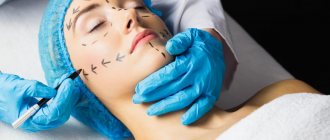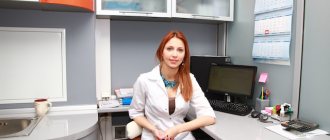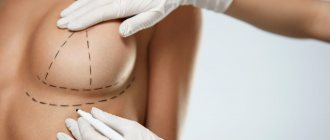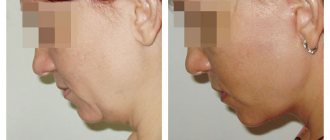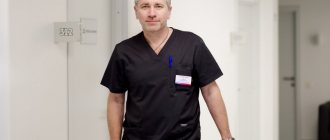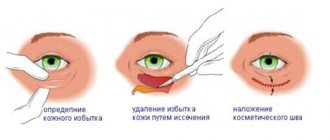Plastic surgery deals with the surgical correction of external and functional disorders of the skin of the face and body. Changes in appearance associated with aging, injuries and illnesses can be eliminated, restoring a person’s confidence in their attractiveness and increasing their quality of life.
Specialists of the Department of Plastic Surgery of the Clinical Hospital "RZD-Medicine" named after. ON THE. Semashko" help to get rid of external defects and disorders, change facial features, restoring their symmetry and aesthetics. Professionals use the wide possibilities of modern medicine to solve various patient problems. Our specialists have innovative techniques and the latest equipment at their disposal. We carry out surgical interventions at a high professional level and in accordance with current international standards.
Indications for plastic surgery
Anyone who is dissatisfied with their appearance and would like to increase their self-confidence can use the services of a plastic surgery clinic. Various congenital and acquired defects negatively affect general well-being and emotional state, suppress people’s activity and interfere with personal relationships.
Main indications for the use of plastic surgery:
- the desire to improve appearance, get rid of aesthetic defects and age-related changes (wrinkles, sagging tissue, double chin, drooping eyelids);
- post-traumatic deformations of the face and body resulting from car accidents, domestic injuries and unsuccessful surgical treatment;
- restoration of the shape and volume of the breast after a mastectomy, prolonged breastfeeding;
- excess fat deposits on the face and body;
- changes in the aesthetics and functionality of the genital organs.
The desire to carry out surgical correction of appearance periodically arises in many people. But before using the services of plastic surgery, you need to make an appointment with a specialist. The doctor will assess the initial condition of the tissues, prescribe a comprehensive examination, and provide complete information about the surgical methods used and possible treatment results.
How everything will be organized
- Initial consultation with a plastic surgeon. We discuss the desired result and possible treatment options.
- Setting a date for surgery.
- Preoperative examination.
- Accommodation in a comfortable room.
- Consultation with an anesthesiologist
- Carrying out the operation.
- Postoperative stay under the supervision of specialists. Examination by a doctor, discharge, as well as appointment of subsequent examinations and dressings.
Features of diagnosis and preparation for surgery
Any operation to correct appearance requires special preparation and a comprehensive examination. Diagnostics includes assessment of the functioning of the cardiovascular, respiratory, digestive and other systems. During the examination, specialists identify possible contraindications and limitations.
Preparation also includes consultations with specialized specialists, including a therapist and resuscitator. The scope of preparatory measures directly depends on the type of planned operation, age and general condition of the patient.
Department of Reconstructive and Plastic Surgery
HEAD OF THE DEPARTMENT OF RECONSTRUCTIVE AND PLASTIC SURGERY Kataev Mikhail Germanovich
Doctor of Medical Sciences, Professor.
The department was organized in 2015. The department includes employees with many years of experience in the field of oculoplasty.
The staff of the department of reconstructive and plastic surgery consults and treats patients with diseases of the eyelids, orbit, lacrimal ducts, eyelashes, as well as anophthalmos. We accept patients with congenital malformations, injuries and traumatic deformities, post-burn scars, consequences of necrotizing dermatoconjunctivitis and combined treatment of cancer, complex types of strabismus, and age-related changes.
Operations are carried out in specially equipped rooms equipped with microscopes, endoscopic stands, video equipment, radiofrequency surgical devices, surgical lasers, special instruments and implants, including proprietary models.
Technologies used:
- classical surgery
- autotransplantation
- use of synthetic implants
- reconstruction using stereolithographic models
- endoscopic surgery
- radiosurgery
- laser surgery
- high frequency electrosurgery
- modern injection technologies
We are ready to advise and help in practice with a variety of clinical problems:
The absence of an eye (anophthalmos) or the need to remove it requires high-quality prosthetics. To compensate for the lost volume of the eyeball, we select the best materials and optimal orbital implants, including those from our own developments, suitable for a particular patient. In complicated cases, with traumatic deformation, with the consequences of radiation therapy of tumors, with congenital underdevelopment of the orbit, we carry out staged surgical preparation to achieve an optimal result.
The most common congenital pathology in our young patients is ptosis of the upper eyelid (blepharoptosis). We make maximum use of the patient's own anatomical resources to obtain the best result. In severe cases, we use the most reliable and stable implantation materials.
Blepharoptosis is not the only malformation; we consult and treat children with blepharophimosis, eyelid colobomas, facial clefts, telecanthus, epicanthus, epiblepharon, euryblepharon, dermoid cysts, lipodermoid, cryptophthalmos and other types of anomalies. In each specific case, we can offer an individual reconstructive treatment plan.
Watery eyes are a painful problem that has different causes at different ages. In children, this is untimely opening of the nasolacrimal duct or its underdevelopment. In simple cases, we probe or stabilize the ducts with a silicone tube. Complex cases require surgery. Most patients are operated on endoscopically. Lacrimation in people of active working age is most often caused by injury or an inflammatory process with a destructive component. From the entire arsenal of treatment methods, including conservative, endoscopic, laser and classical surgical, it is necessary to make an individual choice. This is helped by rich clinical experience and good hardware. The watery eyes of elderly patients are the result of chronic inflammation of the mucous membrane of the tear ducts and nose. When eye drops no longer help, the issue of surgical treatment is decided. Considering that surgery for an elderly person is a difficult ordeal, most often we perform low-traumatic, gentle endoscopic intervention.
Age-related diseases are not limited to lacrimation. Entropion or ectropion of the eyelids are quite traditional problems for elderly patients. We know how to fix them. Moreover, we can choose the method that is most suitable for a particular situation, for example, if urgent intervention is necessary before cataract removal, corneal transplantation or anti-glaucomatous surgery with a minimal rehabilitation period.
Orbital fractures are a real scourge of our time. A huge number of injuries in road accidents, in sports, at work, at home, etc. result in orbital fractures. Orbit is a hub for several related specialties. Patients with trauma are hospitalized in the departments of traumatology, maxillofacial surgery, otorhinolaryngology, and neurosurgery. But since the eye is located in the center of the orbit, the help of an ophthalmologist is first necessary to assess the clinical condition and determine treatment tactics. Strabismus, diplopia, enophthalmos, anophthalmos are reasons for surgical reconstruction of the orbit. But not only. Following this, operations on the eye muscles, eyeball, and soft tissues of the orbit are often necessary. The whole range of problems can be solved in our department.
Complex strabismus of a paralytic or restrictive (scar) nature does not fit into the traditional scheme of simple concomitant strabismus. Returning the eye to a straight position is most often a feasible task for our practice.
Patients with endocrine ophthalmopathy often suffer from associated strabismus, ptosis, or non-closure of the eyelids. In the inactive phase of the disease, we correct these defects.
Injuries and traumatic deformations of the eyelids are very diverse: from small ruptures with damage to the lacrimal canaliculi to extensive destruction with complete loss of the eyelids. Restoring the correct shape of the eyelids, preventing and treating complications traditionally represents a significant part in our surgical practice.
Paralytic lagophthalmos , which occurs as a result of surgical or traumatic damage to the facial nerve, leads to drying of the cornea, keratitis, and the formation of ulcers. We offer about ten surgical treatment options to restore or improve eyelid closure. For each patient, we offer our own option, optimal in terms of therapeutic effect and preservation of aesthetic appearance.
Revision aesthetic blepharoplasty . The need for this type of care arises when patients present with complications after initial blepharoplasty. Eversion of the eyelids, rounding of the eyes, shortening of the palpebral fissure, cicatricial limitation of eyelid mobility, undesirable changes in the shape of the eyes, ptosis or retraction of the eyelids, drying out of the cornea require revision of the altered anatomy of the eyelids and its restoration.
Chemodenervation. Botox. If visitors to beauty salons consider Botox injections to be an exclusively cosmetic procedure, then experts are well aware that chemodenervation with botulinum toxin was originally developed as a method of treating various neurological disorders and spastic muscle conditions. Today, botulinum therapy is used in ophthalmology for the treatment of strabismus, blepharospasm, lagophthalmos, lacrimation as an auxiliary method for reconstructive operations. The correct choice of treatment tactics minimizes the trauma of surgical interventions and increases effectiveness. Treatment is carried out on an outpatient basis. For children, short-term anesthesia is required.
Alignment of small protruding scars, removal of skin and conjunctival cysts, excision of chalazion, coagulation of abnormally growing eyelashes, expansion of lacrimal openings and other minor operations are classified as “minor surgery”. These operations do not take much time, are performed on an outpatient basis, recovery occurs quickly, and work capacity is not interrupted.
Employees of the Department of Reconstructive and Plastic Surgery
Reviews
I had intimate plastic surgery done by Maya Andreevna Andreeva. Super caring doctor. Received a lot of compliments. I was in constant contact and worried. The result is fire. For those who are thinking about surgery and cannot decide. I will try to describe how everything happened for me. Why do I need this? I just wanted everything to look more aesthetically pleasing. I didn’t consider it critical, but since I return to this idea more than once, it means it has to be done. Moreover, now it turns out that the underwear fits a little more comfortably. But the aesthetic side was the main one upon request. I did it for myself. The operation was performed under local anesthesia. It wasn't scary, it wasn't painful, but it was interesting. The whole process. Tired. I counted the dots on the ceiling, looked at the lamps, and managed to fall asleep. The local feeling is that there is no pain at all. I tried to understand what they were doing there now, but I couldn’t. Either they are sewing it up, or they are injecting it, or they are cutting it... it’s not clear at all. Have you finished one side and started on the other? The legs are numb, you need to ask them to move them periodically, this is what caused the main discomfort during the operation, this is in the end. In general, lying in one position for a long time is tiring, and you need to move around. I endured everything calmly, there was purring from time to time, music was playing, the doctors were talking very quietly, everything was peaceful. After the operation, I was taken to the ward. The feeling of the operation is peaceful. In general, everything was very caring, I felt like a cat. A few hours later I went home. Walking is comfortable, sitting is also comfortable. No accompaniment needed here. One has arrived. A day later I went back to work. Healing process and care. Daily processing. I definitely took the prescribed antibiotics. It is important to sit down and move carefully. Tight clothes are a no-no. Sports only in a month or a month and a half - ok. There was no discomfort when walking, everything was fine. The first few days it was swollen and edematous. Then it fell asleep. I don’t remember the days, everything mixed up into a single process. Everything was delayed after 4 weeks. After a month and a half, two months, there was still some feeling of increased sensitivity, although everything had healed. About women's days, the first 4-5 weeks (preferably longer) - only pads, no tampons. More frequent hygiene. After it had healed, the stitches were removed. The edges were visible. But after some more time, when I looked there, everything was generally cool, everything was delayed as much as possible, and it was not clear that there was an operation! No traces visible! About intimacy - in two months it’s possible, if the healing process goes well, maybe faster. Before the operation, do not forget to make sure that you do not have any untreated, even minimal diseases in this area, otherwise this can critically affect the healing and the result.
Patients tell
❝more than 30 years ago I had breast reduction surgery. No more back pain and rude comments from guys. More than 20 years ago I had a tummy tuck and liposuction. No more strangers asking if I'm pregnant or if I've recovered from the muscle damage caused by pregnancy. Shortly after that, I had my lips enlarged. Now I don't look so angry. This year I had my bat wings removed. Now my clothes fit better and I don't look like an old woman. I'm 64, look 50, and am more physically active than most 50-year-olds.❞
Prices
| Name | Price |
| VY lipplasty | 25 000 ₽ |
| Abdominoplasty 1st category of complexity | 170 000 ₽ |
| Abdominoplasty 2nd category of complexity | 200 000 ₽ |
| Abdominoplasty 3rd category of complexity | 280 000 ₽ |
| Upper blepharoplasty | 45 000 ₽ |
Sign up for a consultation First consultation is free!
